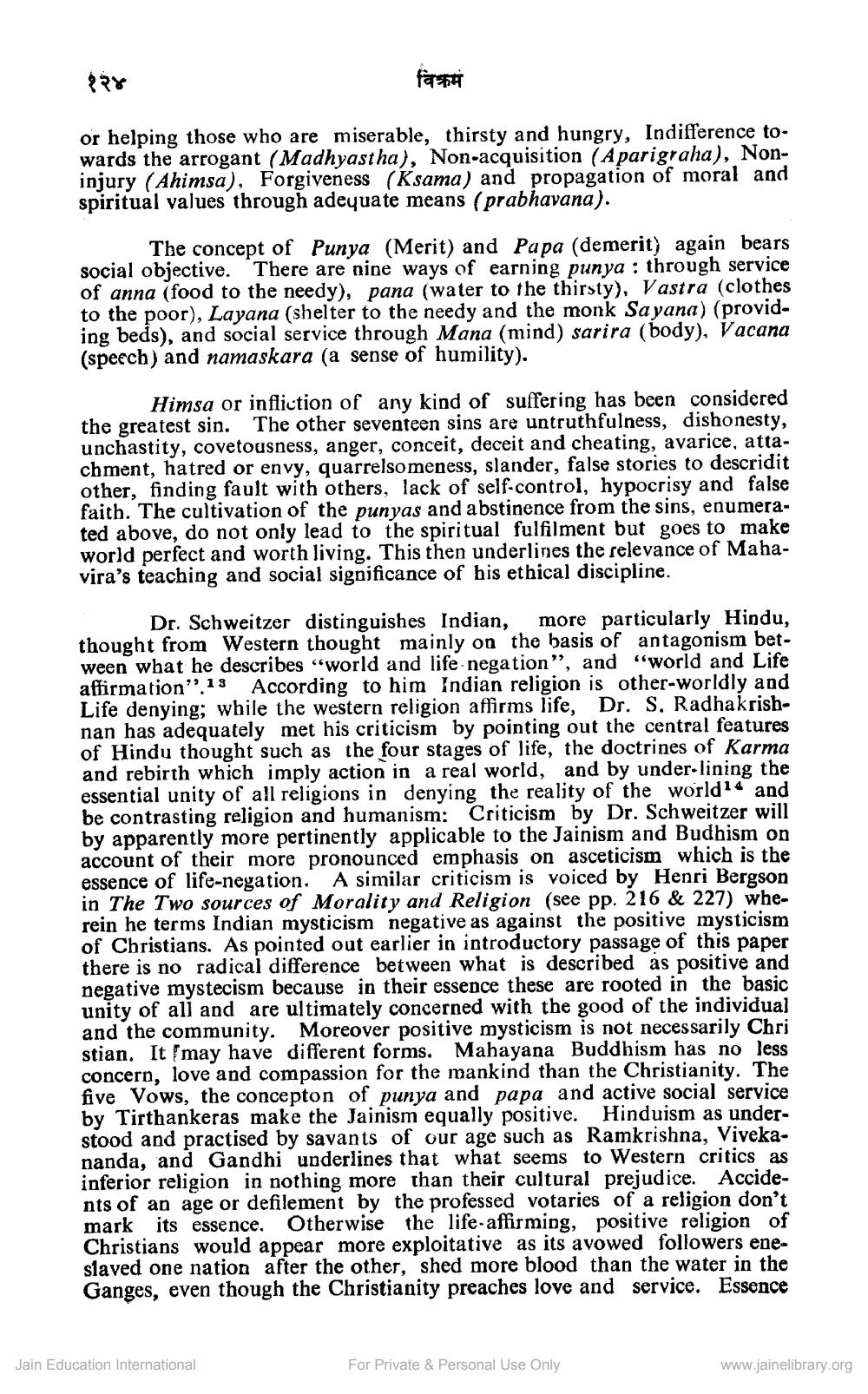________________
विक्रम
or helping those who are miserable, thirsty and hungry, Indifference towards the arrogant (Madhyastha), Non-acquisition (Aparigraha), Noninjury (Ahimsa), Forgiveness (K sama) and propagation of moral and spiritual values through adeyuate means (prabhavana).
The concept of Punya (Merit) and Papa (demerit) again bears social objective. There are nine ways of earning punya : through service of anna (food to the needy), pana (water to the thirsty), Vastra (clothes to the poor), Layana (shelter to the needy and the monk Sayana) (providing beds), and social service through Mana (mind) sarira (body), Vacana (speech) and namaskara (a sense of humility).
Himsa or infliction of any kind of suffering has been considered the greatest sin. The other seventeen sins are untruthfulness, dishonesty, unchastity, covetousness, anger, conceit, deceit and cheating, avarice, attachment, hatred or envy, quarrelsomeness, slander, false stories to descridit other, finding fault with others, lack of self-control, hypocrisy and false faith. The cultivation of the punyas and abstinence from the sins, enumerated above, do not only lead to the spiritual fulfilment but goes to make world perfect and worth living. This then underlines the relevance of Mahavira's teaching and social significance of his ethical discipline.
Dr. Schweitzer distinguishes Indian, more particularly Hindu, thought from Western thought mainly on the basis of antagonism between what he describes “world and life negation”, and “world and Life affirmation".13 According to him Indian religion is other worldly and Life denying; while the western religion affirms life, Dr. S. Radhakrishnan has adequately met his criticism by pointing out the central features of Hindu thought such as the four stages of life, the doctrines of Karma and rebirth which imply action in a real world, and by under lining the essential unity of all religions in denying the reality of the world 14 and be contrasting religion and humanism: Criticism by Dr. Schweitzer will by apparently more pertinently applicable to the Jainism and Budhism on account of their more pronounced emphasis on asceticism which is the essence of life-negation. A similar criticism is voiced by Henri Bergson in The Two sources of Morality and Religion (see pp. 216 & 227) wherein he terms Indian mysticism negative as against the positive mysticism of Christians. As pointed out earlier in introductory passage of this paper there is no radical difference between what is described as positive and negative mystecism because in their essence these are rooted in the basic unity of all and are ultimately concerned with the good of the individual and the community. Moreover positive mysticism is not necessarily Chri stian. It may have different forms. Mahayana Buddhism has no less concern, love and compassion for the mankind than the Christianity. The five Vows, the concepton of punya and papa and active social service by Tirthankeras make the Jainism equally positive. Hinduism as understood and practised by savants of our age such as Ramkrishna, Vivekananda, and Gandhi underlines that what seems to Western critics as inferior religion in nothing more than their cultural prejudice. Accidents of an age or defilement by the professed votaries of a religion don't mark its essence. Otherwise the life-affirming, positive religion of Christians would appear more exploitative as its avowed followers eneslaved one nation after the other, shed more blood than the water in the Ganges, even though the Christianity preaches love and service. Essence
Jain Education International
For Private & Personal Use Only
www.jainelibrary.org




